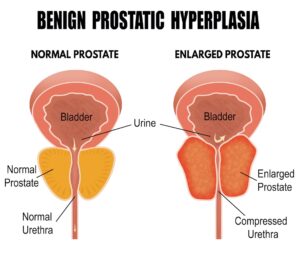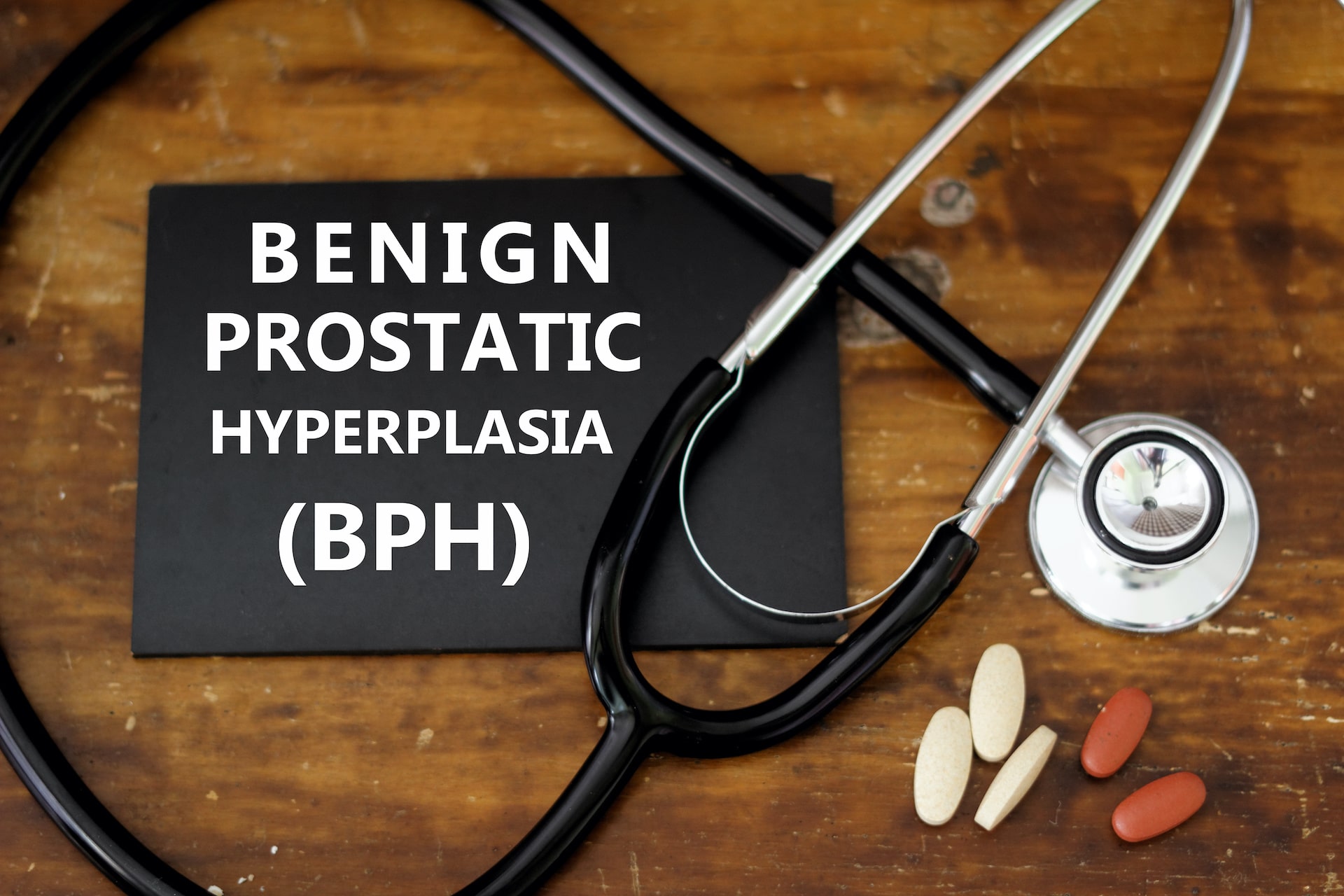Benign Prostatic Hyperplasia (BPH), commonly referred to as an enlarged prostate, is a non-cancerous condition that affects many men as they age. While the prostate typically grows slowly after a man reaches his 20s, significant enlargement can occur after age 40, leading to bothersome urinary symptoms. Understanding the available BPH treatment options is essential for managing BPH effectively and maintaining a good quality of life. At Kansas City Urology and Oncology (KCUC), we offer many treatments for BPH.
 Dr. Nate Ballek, prosthetic urologist and men’s health specialist with KCUC, recently recorded a men’s health webinar titled “Signs, Symptoms, and Treatment Options for Erectile Dysfunction and BPH” where he addresses BPH and explains all of the ways it can be treated as well as erectile dysfunction symptoms and treatments. We are focusing exclusively on BPH in this article, but here is a link to that webinar if you prefer to watch it: Signs, Symptoms, and Treatment Options for Erectile Dysfunction and BPH.
Dr. Nate Ballek, prosthetic urologist and men’s health specialist with KCUC, recently recorded a men’s health webinar titled “Signs, Symptoms, and Treatment Options for Erectile Dysfunction and BPH” where he addresses BPH and explains all of the ways it can be treated as well as erectile dysfunction symptoms and treatments. We are focusing exclusively on BPH in this article, but here is a link to that webinar if you prefer to watch it: Signs, Symptoms, and Treatment Options for Erectile Dysfunction and BPH.
Understanding BPH
 The prostate is a walnut-sized gland located at the base of the bladder, surrounding the urethra. Its primary function is reproductive, contributing to the production of seminal fluid. As men age, the prostate naturally enlarges, a process influenced by genetics and hormonal changes. While some men experience minimal growth, others develop significant enlargement, leading to urinary issues known as lower urinary tract symptoms (LUTS).
The prostate is a walnut-sized gland located at the base of the bladder, surrounding the urethra. Its primary function is reproductive, contributing to the production of seminal fluid. As men age, the prostate naturally enlarges, a process influenced by genetics and hormonal changes. While some men experience minimal growth, others develop significant enlargement, leading to urinary issues known as lower urinary tract symptoms (LUTS).
Symptoms of BPH
BPH does not cause or indicate prostate cancer, but its symptoms can be disruptive. Common symptoms include:
- Frequent urination, especially at night (nocturia)
- Weak or interrupted urine stream
- Sudden urge to urinate
- Difficulty starting urination
- Incomplete bladder emptying
- Painful urination in some cases
These symptoms can significantly impact daily life, making timely diagnosis and treatment of BPH essential.
Diagnosing BPH
Diagnosing BPH involves a combination of medical history, physical examination, and diagnostic tests. Common assessments include:
- Digital Rectal Exam (DRE): Helps evaluate prostate size and detect abnormalities.
- Post-Void Residual Test: Measures how much urine remains in the bladder after urination.
- Uroflowmetry: Determines the rate of urine flow.
- Prostate-Specific Antigen (PSA) Test: While not specific to BPH, elevated PSA levels may prompt further investigation to rule out prostate cancer.
- International Prostate Symptom Score (IPSS): A questionnaire assessing symptom severity and impact on quality of life.
Treatment Options for Enlarged Prostate
Treatment for BPH depends on symptom severity, prostate size, and individual patient preferences. Options range from lifestyle modifications and medications to minimally invasive procedures and surgery.
1. Watchful Waiting
For men with mild symptoms, lifestyle modifications and regular monitoring may be sufficient. This approach includes:
- Reducing caffeine and alcohol intake
- Managing fluid consumption before bedtime
- Practicing bladder training techniques
- Engaging in regular exercise to maintain overall health
2. Medications
 When symptoms become more bothersome, medications may be prescribed:
When symptoms become more bothersome, medications may be prescribed:
- Alpha Blockers: These medications, such as tamsulosin and alfuzosin, relax the muscles in the prostate and bladder neck to improve urine flow. They work quickly but do not shrink the prostate.
- 5-Alpha Reductase Inhibitors: Drugs like finasteride and dutasteride block the conversion of testosterone to dihydrotestosterone (DHT), a hormone that contributes to prostate growth. These medications can reduce prostate size but may take several months to show results.
- Combination Therapy: Some patients benefit from taking both alpha blockers and 5-alpha reductase inhibitors for a more comprehensive approach.
- Phosphodiesterase-5 (PDE5) Inhibitors: Medications like tadalafil, commonly used for erectile dysfunction, may also help relieve BPH symptoms.
3. Minimally Invasive Procedures
When medications are ineffective or cause side effects, minimally invasive treatments offer effective alternatives:
- Water Vapor Therapy (Rezūm): Uses steam to destroy excess prostate tissue, creating a wider urinary channel. This procedure preserves ejaculatory function and has a relatively short recovery time.
- Prostatic Urethral Lift (UroLift): Small implants are placed to pull prostate tissue away from the urethra, reducing obstruction without removing tissue. KCUC has been designated a UroLIFT Center of Excellence by Teleflex. The designation recognizes the KCUC team, specifically doctors Jason Anast, MD, Susan Sweat, MD, and Gerald Park, MD, for their expertise with UroLIFT® Therapy.
4. Surgical Treatments
For severe cases of BPH, surgical intervention may be necessary:
- Aquablation Therapy: A heat-free water jet removes the excess prostate tissue precisely and more safely than with other methods that use heat. Aquablation provides long-lasting relief with low rates of complications.
- Laser Therapy: Techniques like GreenLight laser therapy vaporize excess prostate tissue, improving urinary flow with minimal blood loss.
- Transurethral Resection of the Prostate (TURP): Considered the gold standard for BPH surgery, TURP involves removing excess prostate tissue through the urethra, providing long-term relief.
- Holmium Laser Enucleation of the Prostate (HoLEP): Uses laser technology to remove large prostate sections, ideal for significantly enlarged prostates.
- Open or Robotic Prostatectomy: Rarely used today, this procedure is reserved for extremely large prostates when other treatments are ineffective.
Choosing the Right Treatment for Enlarged Prostate
While an enlarged prostate can be bothersome, effective treatments are available. Deciding on the best treatment for BPH depends on multiple factors, including symptom severity, prostate size, overall health, and personal preferences. While medications and minimally invasive procedures work well for many men, surgery remains a viable option for those with severe symptoms or complications like bladder stones or urinary retention.
Compassionate, Patient-Centered Care
 Kansas City Urology & Oncology (KCUC) is dedicated to providing expert care for men’s health issues, from enlarged prostate to prostate cancer treatment. But at KCUC, our commitment to excellence extends beyond medical expertise. We understand the emotional and physical challenges of urologic and oncologic diagnoses and we believe in treating each patient as a whole person. By emphasizing emotional support alongside physical health, we strive to reduce stress and anxiety, providing holistic care to make your healthcare journey a little easier. We call it Patient-First Care. At KCUC, you can trust that you are receiving advanced, compassionate care from a team of board-certified urologists and oncologists dedicated to achieving the best outcomes.
Kansas City Urology & Oncology (KCUC) is dedicated to providing expert care for men’s health issues, from enlarged prostate to prostate cancer treatment. But at KCUC, our commitment to excellence extends beyond medical expertise. We understand the emotional and physical challenges of urologic and oncologic diagnoses and we believe in treating each patient as a whole person. By emphasizing emotional support alongside physical health, we strive to reduce stress and anxiety, providing holistic care to make your healthcare journey a little easier. We call it Patient-First Care. At KCUC, you can trust that you are receiving advanced, compassionate care from a team of board-certified urologists and oncologists dedicated to achieving the best outcomes.
If you’d like to learn more about KCUC and our BPH treatment options, contact one of the over 30 KCUC Urology and Oncology locations throughout Kansas and Missouri and schedule an appointment to see Dr. Ballek or one of our other board-certified urologists to explore your BPH treatment options and end the annoying symptoms. At KCUC, you see the best in KC.

For more information about office-based proton therapy at KCPI
and helpful tips for your healthcare journey, visit our Facebook page.

